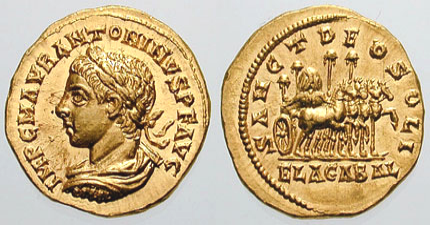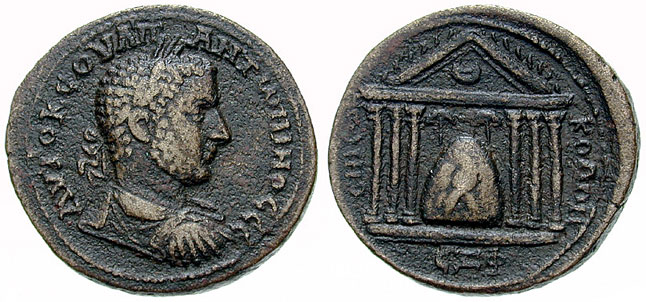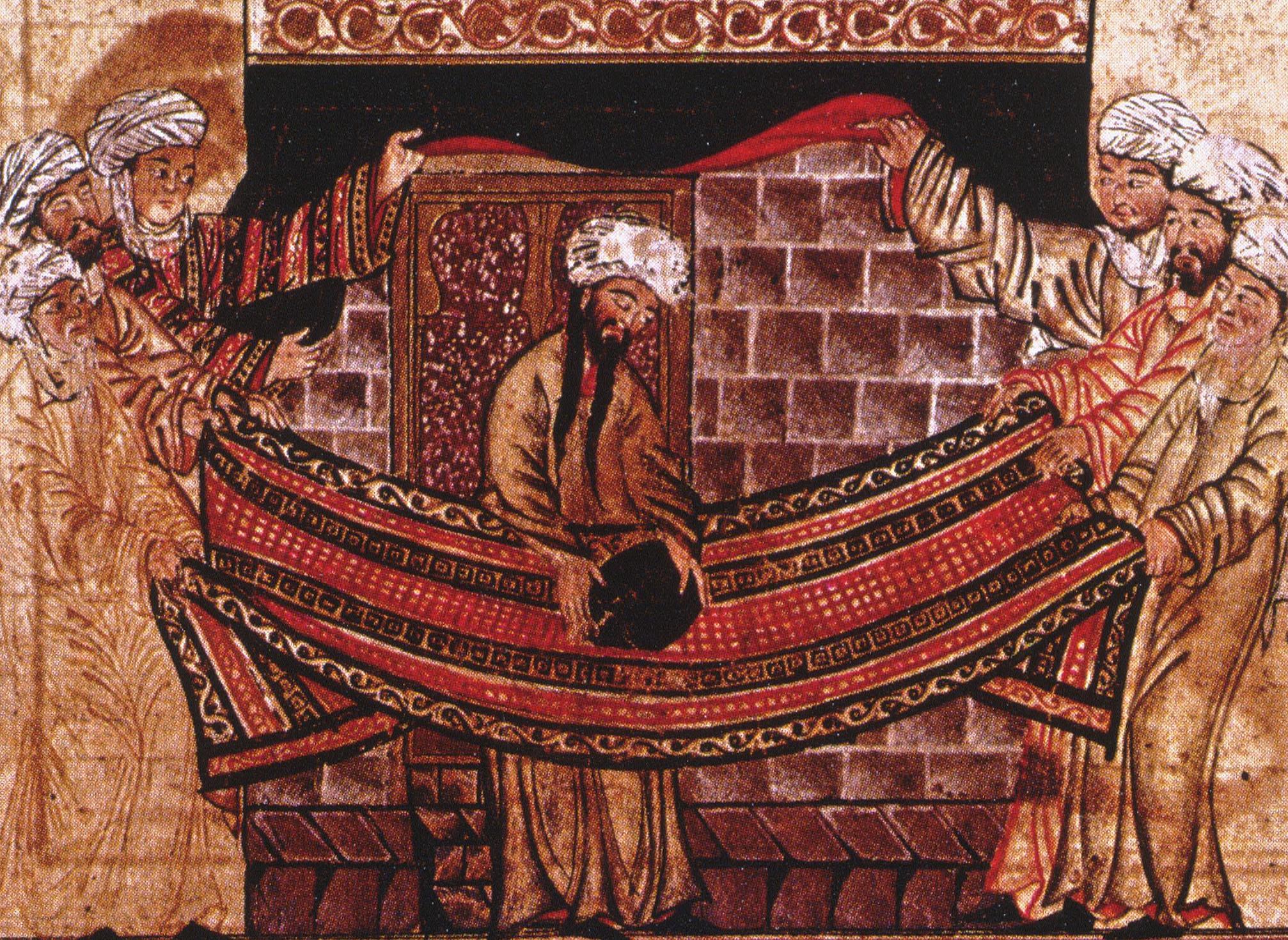
Posted on 07/23/2015 1:09:56 AM PDT by Cronos
| "Elagabalus Aureus Sol Invictus" by Classical Numismatic Group, Inc. http://www.cngcoins.com. Licensed under CC BY-SA 3.0 via Wikimedia Commons |
The name is the Latinized form of the Syrian Ilāh hag-Gabal, which derives from Ilāh"god" and gabal "mountain" (compare Arabic: جبل jabal), resulting in "the God of the Mountain" the Emesene manifestation of the deity.
Lenormant, Francois (1881). "Sol Elagabalus". Revue de l'Histoire des Religions 3: 310.
The cult statue was brought to Rome by the Emperor Marcus Aurelius Antoninus, who before his accession was the hereditary high priest at Emesa and is commonly called Elagabalus after the deity. The Syrian deity was assimilated with the Roman sun god known as Sol Invictus ("the Undefeated Sun").
A temple called the Elagabalium was built on the east face of the Palatine Hill, to house the holy stone of the Emesa temple, a black conical meteorite. Herodian writes of that stone:
"This stone is worshipped as though it were sent from heaven; on it there are some small projecting pieces and markings that are pointed out, which the people would like to believe are a rough picture of the sun, because this is how they see them."
Herodian Roman History V,3
Herodian also relates that Elagabalus forced senators to watch while he danced around his deity's altar to the sound of drums and cymbals, and at each summer solstice celebrated a great festival, popular with the masses because of food distributions, during which he placed the holy stone on a chariot adorned with gold and jewels, which he paraded through the city:
"A six horse chariot carried the divinity, the horses huge and flawlessly white, with expensive gold fittings and rich ornaments. No one held the reins, and no one rode in the chariot; the vehicle was escorted as if the god himself were the charioteer. Elagabalus ran backward in front of the chariot, facing the god and holding the horses reins. He made the whole journey in this reverse fashion, looking up into the face of his god."
Herodian Roman History V,3
Herodian's description strongly suggests that the Emesene cult was inspired by the Babylonian Akitu-festival.
 |
| "Bronze-Uranius Antoninus-Elagabal stone-SGI 4414". Licensed under Public Domain via Wikimedia Commons |
The Emperor also tried to bring about a union of Roman and Syrian religion under the supremacy of his deity, which he placed even above Jupiter, and to which he assigned either Astarte, Minerva or Urania, or some combination of the three, as wife.
The most sacred relics from the Roman religion were transferred from their respective shrines to the Elagabalium, including "the emblem of the Great Mother, the fire of Vesta, the Palladium, the shields of the Salii, and all that the Romans held sacred."
He reportedly also declared that Jews, Samaritans and Christians must transfer their rites to his temple so that it "might include the mysteries of every form of worship."
Wikipedia
The exact origin of the Elagabalus stone remains obscure, but in historical times its destiny was closely interwined with that of a dynasty of king-priests who had been nomads, Beduins of the desert, before settling down in Emesa to erect a shire to Elagabalus. Eventually, the cult became famous and popular, so much that Elagabalus ended up being the chief deity of the Roman Empire under the title "deus invictus Sol Elagabalus," albeit for a short period of time, between A.D. 218 and 222.Because of its apparently huge size the meteorite would be of great interest to modern astronomers. But it is possible that six horses shown in the golden coin were needed to carry not only the stone but the structures emphasizing its holiness. Similarly, the stone shown in the Uranius is hardly in scale with the temple depicted but rather a detailed image of how it looked.
Bellamare 1996 p. 287
As for the black stone, it was quietly shipped back to Syria and reinstalled in the temple of Emesa. It was probably smashed to pieces when the temple was converted into a Christian church, some time in the 4th century. The site, now occupied by a mosque, has never been excavated. All that remians of the mysterious black stone are ancient texts and a collection of iconographic documents, mostly coins.It might have been smashed into pieces. Or sensing the danger priests of Elagabalus could have moved it somewhere to safety before Christians took over the ancient holy site of the temple.
Bellamare 1996, p. 288

| "Elagabalus Aureus Sol Invictus" by Classical Numismatic Group, Inc. http://www.cngcoins.com. Licensed under CC BY-SA 3.0 via Wikimedia Commons |
The name is the Latinized form of the Syrian Ilāh hag-Gabal, which derives from Ilāh"god" and gabal "mountain" (compare Arabic: جبل jabal), resulting in "the God of the Mountain" the Emesene manifestation of the deity.
Lenormant, Francois (1881). "Sol Elagabalus". Revue de l'Histoire des Religions 3: 310.
The cult statue was brought to Rome by the Emperor Marcus Aurelius Antoninus, who before his accession was the hereditary high priest at Emesa and is commonly called Elagabalus after the deity. The Syrian deity was assimilated with the Roman sun god known as Sol Invictus ("the Undefeated Sun").
A temple called the Elagabalium was built on the east face of the Palatine Hill, to house the holy stone of the Emesa temple, a black conical meteorite. Herodian writes of that stone:
"This stone is worshipped as though it were sent from heaven; on it there are some small projecting pieces and markings that are pointed out, which the people would like to believe are a rough picture of the sun, because this is how they see them."
Herodian Roman History V,3
Herodian also relates that Elagabalus forced senators to watch while he danced around his deity's altar to the sound of drums and cymbals, and at each summer solstice celebrated a great festival, popular with the masses because of food distributions, during which he placed the holy stone on a chariot adorned with gold and jewels, which he paraded through the city:
"A six horse chariot carried the divinity, the horses huge and flawlessly white, with expensive gold fittings and rich ornaments. No one held the reins, and no one rode in the chariot; the vehicle was escorted as if the god himself were the charioteer. Elagabalus ran backward in front of the chariot, facing the god and holding the horses reins. He made the whole journey in this reverse fashion, looking up into the face of his god."
Herodian Roman History V,3
Herodian's description strongly suggests that the Emesene cult was inspired by the Babylonian Akitu-festival.
 |
| "Bronze-Uranius Antoninus-Elagabal stone-SGI 4414". Licensed under Public Domain via Wikimedia Commons |
The Emperor also tried to bring about a union of Roman and Syrian religion under the supremacy of his deity, which he placed even above Jupiter, and to which he assigned either Astarte, Minerva or Urania, or some combination of the three, as wife.
The most sacred relics from the Roman religion were transferred from their respective shrines to the Elagabalium, including "the emblem of the Great Mother, the fire of Vesta, the Palladium, the shields of the Salii, and all that the Romans held sacred."
He reportedly also declared that Jews, Samaritans and Christians must transfer their rites to his temple so that it "might include the mysteries of every form of worship."
Wikipedia
The exact origin of the Elagabalus stone remains obscure, but in historical times its destiny was closely interwined with that of a dynasty of king-priests who had been nomads, Beduins of the desert, before settling down in Emesa to erect a shire to Elagabalus. Eventually, the cult became famous and popular, so much that Elagabalus ended up being the chief deity of the Roman Empire under the title "deus invictus Sol Elagabalus," albeit for a short period of time, between A.D. 218 and 222.Because of its apparently huge size the meteorite would be of great interest to modern astronomers. But it is possible that six horses shown in the golden coin were needed to carry not only the stone but the structures emphasizing its holiness. Similarly, the stone shown in the Uranius is hardly in scale with the temple depicted but rather a detailed image of how it looked.
Bellamare 1996 p. 287
As for the black stone, it was quietly shipped back to Syria and reinstalled in the temple of Emesa. It was probably smashed to pieces when the temple was converted into a Christian church, some time in the 4th century. The site, now occupied by a mosque, has never been excavated. All that remians of the mysterious black stone are ancient texts and a collection of iconographic documents, mostly coins.It might have been smashed into pieces. Or sensing the danger priests of Elagabalus could have moved it somewhere to safety before Christians took over the ancient holy site of the temple.
Bellamare 1996, p. 288
It's not hard to believe that they went south to the lands just outside the reach of the Empire and between the Empire and the Axumite Empire.
Could be the best theory I have read on the stone.
Thanks for the post.
Presently, "there is no other god" than Allah, and Hajar-al-Aswad is now alone at this focus of all Muslim worship, at Mecca.
I suppose it's no stretch.




The name of Al-ilah el gabal (the god of the moountains) parallels Al-illah (Allah = the god). The followers of Elgabalus had to be circumcised and were not allowed to eat pork.
The walking around the Kaaba 7 times is also an old semitic practice
The circling of the kaaba is a survival from the days of the worship of Saturn — the circling mimicking the rings, which were somehow known in ancient times. The kaaba itself used to have a large, seated idol, roundish and human-like, perhaps even buddha-like, and the site of course antedates Elagabalus (who eventually castrated himself as part of his religion, if memory serves) by millennia. It’s *possible* that the Black Stone was added much later, obviously. The idol, as well as the statues which used to line the avenue to the shrine, was destroyed eventually by the muzzies, clearly alterations have been made. The staircase that used to run from one corner up to the top of the kaaba was filled in long ago, for another example.
worship of Saturn? can you explain more? I thought most early civilisations worshipped the Sun and Moon and at the most Jupiter.
Right now I think that possible Mohammed used the logic of a monotheistic religion revolving around the worship of the black rock as a way to unify the Arab tribes.
It’s a puzzle and will remain puzzling, due to the guesswork involved.
World’s oldest telescope? [ Assyrian telescope? ]
http://www.freerepublic.com/focus/chat/1879740/posts
I was suddenly struck by the, uh, irony, or somethin’:
http://www.theoi.com/Titan/TitanKronos.html
https://en.wikipedia.org/wiki/Chronos
https://en.wikipedia.org/wiki/Cronus
That could be true, regardless. He didn’t invent anything, apart from the mindf***, he just used what was around.
Plus the clear appeal of islam to warrior men in its doctrines and living
The Major Religions of the World ....Revisited: The Significance of Mecca
http://www.freerepublic.com/focus/chat/2770618/posts
Travels in Arabia, by John Lewis Burckhardt
Some Historical Notices Concerning the Kaaba, and the Temple of Mekka; Extracted from the Works of El Azraky, El Fasy, Kotobeddyn, and Asamy, Writers More Particularly Mentioned in the Introduction.
http://ebooks.adelaide.edu.au/b/burckhardt/john_lewis/arabia/chapter10.html
[snip] An Arab of Kossay, named Ammer Ibn Lahay, first introduced idolatry among his countrymen; he brought the idol, called Hobal, from Hyt, in Mesopotamia, [See El Azraky.] and set it up at the Kaaba. Idolatry then spread rapidly; and it seems that almost every Arab tribe chose its own god or tutelar divinity; and that, considering the Kaaba as a Pantheon common to them all, they frequented it in pilgrimage. The date-tree, called Ozza, says Azraky, was worshipped by the tribe of Khozaa; and the Beni Thekyf adored the rock called El Lat; a large tree, called Zat Arowat, was revered by the Koreysh; the holy places, Muna, Szafa, Meroua, had their respective saints or demi-gods; and the historians give a long list of other deities. The number of idols increased so much, that one was to be found in every house and tent of this valley; and the Kaaba was adorned with three hundred and sixty of them, corresponding probably to the days of the year. [/snip]
http://www.freerepublic.com/focus/chat/2770618/posts?page=3#3
Was the Kaaba Originally a Hindu Temple?
by P.N. Oak
http://www.freerepublic.com/focus/chat/2770618/posts?page=8#8
Is Kaaba an ancient Hindu Shiva Temple confiscated by Muhammad during raids?
https://themuslimissue.wordpress.com/2013/01/04/is-the-kaaba-an-ancient-hindu-shiva-temple-confiscated-by-mohammed/comment-page-4/
Is Kaaba in Mecca actually a lord Shiva Lingam?
http://www.quora.com/Is-Kaaba-in-Mecca-actually-a-lord-Shiva-Lingam
Kaaba, a Hindu Temple, Stolen by Muslims
http://haribhakt.com/kaaba-a-hindu-temple-stolen-by-muslims/
Kaaba of Mecca and The Hindu connection?
http://hinduism.stackexchange.com/questions/7224/kaaba-of-mecca-and-the-hindu-connection
Mecca was a Hindu Temple?
https://answers.yahoo.com/question/index?qid=20100623071329AAZdev6
Shiva Linga In Mecca, OM Is 786?
https://ramanan50.wordpress.com/2013/12/02/shiva-linga-in-mecca-om-is-786/
You know that.. Kaaba was a Hindu Temple taken over by Muslims
http://www.danielpipes.org/comments/178056
Disclaimer: Opinions posted on Free Republic are those of the individual posters and do not necessarily represent the opinion of Free Republic or its management. All materials posted herein are protected by copyright law and the exemption for fair use of copyrighted works.